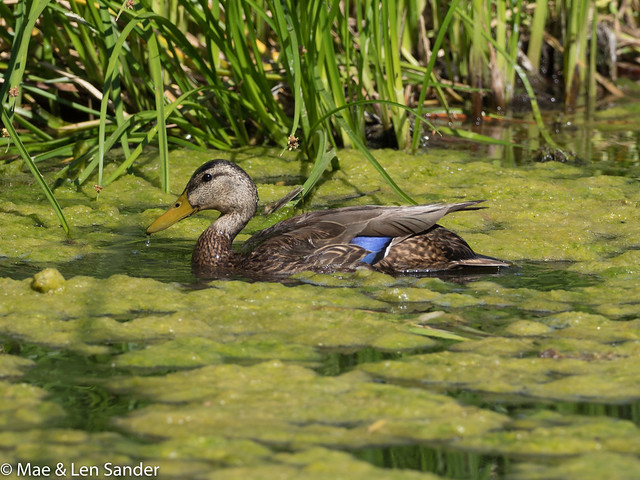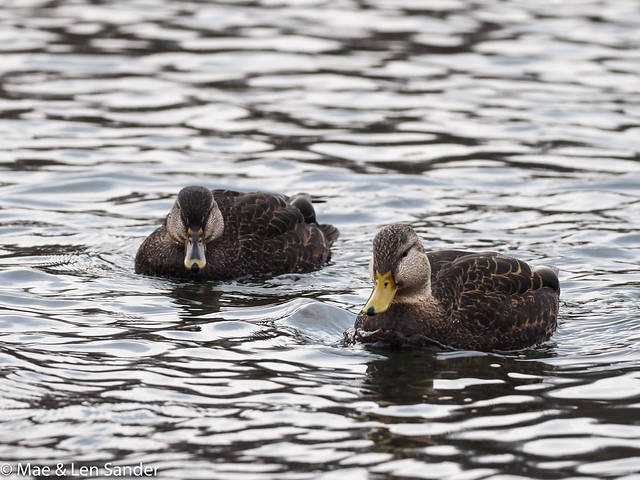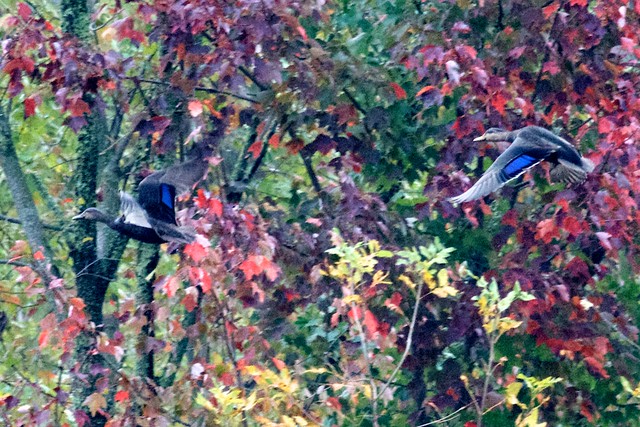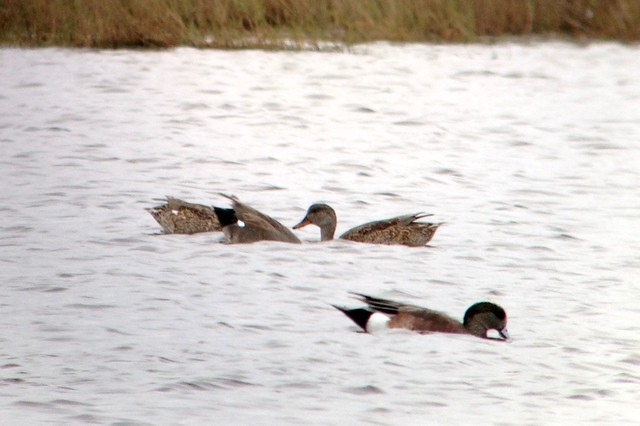The Mallard Duck is a remarkable creature. Birders rarely give them a second
glance or take photos of them, because they are so common. You can see them
anywhere, from ponds in city parks to irrigated farmlands or wild marshlands. You can see them on
almost every continent. They are native to most of the temperate northern
hemisphere, and haver adapted after introductions into many southern
hemisphere locations. In North America, the mallard population is over 10 million birds.
From a birder's perspective, mallards are totally boring. Not being a true birder, I see them as remarkable for their ability to live almost anywhere; breed prolifically; eat a
variety of insects, plants, and sometimes small birds; and enjoy all sorts of
environments. Sort of like humans.
Mallards have a few close relatives -- species that may have mallard ancestors
but have become isolated or otherwise estranged from their mallard relatives,
and thus evolved into separate species. Below are some of the photos that Len and I have taken over the years, of mallards and their close relatives.

Mallard Duck, Ann Arbor, Michigan. We have them EVERYWHERE! The male, with his iridescent green head and bright orange feet is actually quite attractive.
 |
| Shinobazo Pond, Ueno Park, Tokyo. The remotest place I've seen mallards. |
Mallards have many relatives...
Black Duck, Ann Arbor. The black duck is a related to the mallard. They are comparatively rare; we see them in small numbers in the winter.
"Historically, the mallard's close relative, the American black duck, was
the most abundant duck in the Atlantic Flyway, and black ducks were
once far more numerous in the Mississippi Flyway than they are
today. Black duck breeding populations have declined by more than 50 percent
since the late 1950s. Habitat loss and competition and hybridization
with mallards are believed to be the primary causes of past black duck
declines." (
source)
Black Ducks, this week in Ann Arbor.
Black Duck, Lancaster County, PA. The above photo shows the
wing patch that identifies them.
Mottled Duck, Merrit Island, Florida. (Photographed with American widgeons.) The mottled duck is another
close relative of mallards. Most mottled ducks -- around 600,000 birds -- live along the Gulf Coast of Texas and Louisiana, but these are members of a smaller population of around 40,000 ducks. "These Florida mottled ducks are typically found in freshwater emergent wetlands, wet prairies, and seasonally flooded marshes. In addition, mottled ducks from the Gulf Coast have been introduced in coastal South Carolina. Important mottled duck foods include rice, moist-soil plant seeds, submerged aquatic vegetation, and invertebrates." (
source)

Mexican Duck, Tucson, AZ. Until 2020, the Mexican Duck was classified
as a subspecies of mallard, but after further study, the American
Ornithological Society confirmed them as a separate species. "After
analyzing the duck’s DNA, the organization reclassified the duck as closely
related to mallards, black ducks, and mottled ducks, but distinct." (
source)
Hawaiian Duck or Koloa, Hanalei NWR, Kauai, Hawaii. This is a rare and endangered species, endemic to the Hawaiian Islands, mainly found on Kauai. It is under threat from habitat loss, predation by wild and domestic animals, and interbreeding with mallards. Ongoing efforts at conservation of this rare species may be succeeding in protecting it, particularly efforts to keep mallards out of Kauai and thus reduce hybridization. (
source)
Unfortunately, the overwhelming ability of the mallard to hybridize with many other species, such as the Hawaiian Duck, makes them unwelcome and invasive in many places, such as New Zealand, where they are a threat to the New Zealand grey duck, in South America where they threaten various native species, or in Florida, where they threaten the mottled duck.
Unappreciated Species
It's easy to overlook the remarkable persistence of some species as a defining and interesting feature. A while back I wrote about the coot, a very common bird that's often
ignored by birders. (See "
A Remarkable Bird, The Coot.") There are a few other birds that fascinate me in the same way, for their ability to live in a wide variety of environments and to populate -- or even overpopulate -- the places they go.
Blog post © 2022 mae sander. Photos copyright 2011-2022 by mae and len sander.









11 comments:
A friend of ours is a duck expert so I can discuss this with him on Saturday night when he visits. Thanks for the conversation starter.
Oh, I must have a closer look, but our males have a green head as well. The females are brown/grey...
I love mallards. Maybe it's because I see them so often but I can never resist a photo, especially of their beautiful green heads or back feathers. Watch one closely sometime when they blink. I took some photos once, and didn't realize (it's so fast) but when you see it stopped it's kind of creepy. I wonder if they'd think the same of us!
We have mallards here, and I love them :) The fact that the males and females are different, that I see them in pairs and family groups, that they look so adorable in the water with their babies lined up behind... I may be easy to please, but they're a highlight of any lake when I see them :)
I too never tire of observing Mallards. And I am as awed by your knowledge as I am by the lovely pictures . And I think you really *are* a true birder in the most important definition of the phrase. I think that deep knowledge as well as your obvious love of birds is far more important than counting numbers for a life list. That being said however I now really want to go find a Florida mottled duck (nobody ever said that consistency was one of my strong points.)
I have never seen Mallards. The male is certainly beautiful like most male birds. Very nice pictures in this post.
Hello,
I enjoy seeing all the ducks, the Mallards are beautiful. They do seem common to see here, our American Black Ducks show up more in the winter months. I am not sure if I have seen the Mottled Duck. It is sad to hear any bird is considered endangered. Wonderful photos, post and information. Thank you for linking up and sharing your post. Take care, have a happy weekend. PS, thank you for leaving me a comment.
Hello,:=) The Mallard, although a common duck is always a pleasure to see. I don't know the others, but enjoyed reading about them.
What beautiful photos of these ducks. We have hybrids here in FL and it makes it even harder to ID them all! Happy weekend!
You have shown us some beautiful ducks, especially the mallards. I like what you wrote about the coot and I can appreciate the overpopulating. For me that is the Canadian geese who have taken up residence on our rivers. If only people would stop feeding them, but they seem to think they are cute.
we have lots of malards. It´s quite a nice bird. :)
Post a Comment